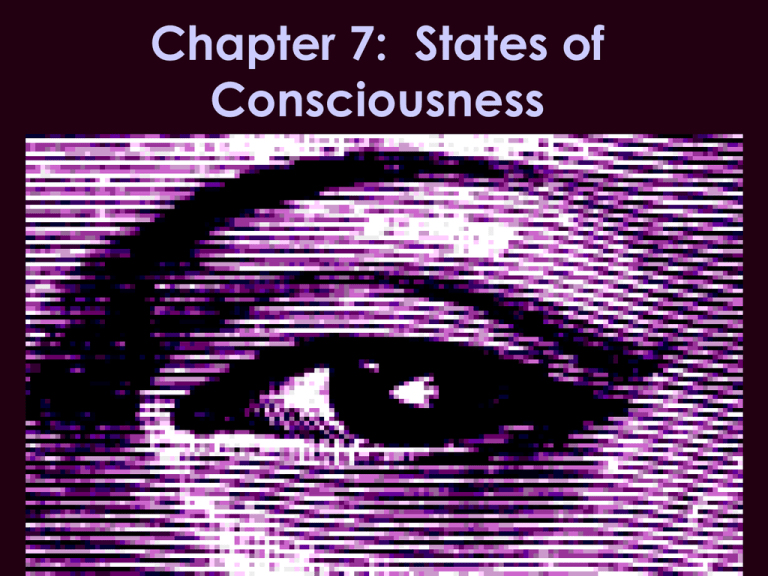
Chapter 7: States of
Consciousness
What is Consciousness?
• Consciousness has been
defined by psychologists as our
awareness of ourselves and our
environment.
• The awareness varies
depending on our attention to
the task at hand. Ex: driving.
Consciousness and
Information Processing
• Consciousness describes what we are
aware of but many things are
processed outside of our
“consciousness.”
• Difficult or novel tasks require more
conscious attention than well learned
tasks.
• Consciousness has a limited capacity
Daydreams and Fantasies
• Almost everyone daydreams at one point or
another.
• Young adults tend to fantasize more than older
adults, and admit to more sexual fantasies.
• Although 95% of all people have sexual
fantasies, men tend to fantasize more than
women.
• Fantasy-prone personality: someone who
imagines and recalls experiences with lifelike
vividness and who spends considerable time
fantasizing.
Why Might Daydreaming Be
Helpful and Adaptive for
Humans?
•
•
•
•
•
A way to escape
Prepare for future events
Aware of unfinished business
Increase creativity
Substitute for impulsive behavior
Biological Rhythms
• Biological Rhythms: periodic
physiological fluctuations built
into human beings.
Ex: 28 day menstrual cycle, 24
hour alertness cycle, annual
cycle, 90 minute sleep cycles.
• Circadian Rhythm: biological
clock that regulates body
rhythms on a 24 hour
cycle….larks vs. owls.
Sleep
• Sleep: refers to the
periodic, natural,
reversible loss of
consciousness.
• Using an EEG, sleep
researchers have shown
the mind is “awake”
during various stages of
sleep.
Sleep Stages: NREM-1/Stage 1
• As we lay with our eyes closed we are in an
awake but highly relaxed state characterized by
alpha waves (slow waves) being emitted from
our brain.
• As we fall asleep, we have a 50% decrease in
alpha wave activity…sometimes referred to as
“drowsy sleep.”
• During NREM-1 sleep, we often experience
hallucinations: false sensory experiences. We
may feel a sensation of falling or floating.
– 5 minutes
NREM-2/Stage 2: Sleep Spindles
• After about 5 minutes in NREM-1, you sleep
into NREM-2 sleep which is characterized by
Sleep Spindles: bursts of rapid, rhythmic,
brain wave activity.
• Stage where you are clearly asleep, sleep
talking can occur in this stage or any other
later stage.
– 20 minutes
NREM-3/Stage 3: Transition
Stage
• Stage Three begins your descent into
“slow wave sleep.”
• Delta Waves: (large, slow brain waves
associated with deep sleep) begin
appearing in stage 3 but are increasingly
apparent in Stage 4.
Did you hear that storm last
night??
NREM-3 continued
“Stage Four”: Delta Waves
• Stage of deep sleep
characterized by Delta
Waves.
• Stage when you are hard to
awaken…but still aware of
stimuli around you.
• Stage at which children may
wet the bed or sleep walk.
• Also experience night terrors.
Night Terrors
• Occur during late
NREM-3 sleep and
are characterized
by high arousal
and an
appearance of
terror but are
seldom
remembered.
R.E.M. Sleep (Paradoxical
Sleep)
• After NREM-3,
your bodies cycles
back to NREM-2,
NREM-1, and into
REM sleep.
• A Normal Sleep
cycle lasts about
90 minutes.
R.E.M. Sleep (Paradoxical Sleep)
• R.E.M.: rapid eye movement sleep, stage where
vivid dreams occur. Known as Paradoxical
because muscles are relaxed yet body is highly
active.
• Heart rate increases, Breathing more rapid, eyes
dart behind lids.
• Genitals become aroused during R.E.M. sleep even
when dreams are not sexual in nature.
• As sleep cycle continues, R.E.M. sleep gets longer
and longer.
Brain Waves and Stages of Sleep
So Why Do We Sleep?
• Most people will sleep for 9 hours if they
could
• Sleep debt
• Decrease in work productivity
• Increase in auto accidents
• Suppressed immune system
• Alter metabolic and hormonal functioning
• Decrease in performance and creativity
Sleep Function
• Theories:
–Sleep protects
–Helps us recuperate
–Restore and rebuild our fading
memories of the day’s experience
–Feeds creative thinking
–Supports growth (pituitary gland)
Sleep Deprivation
Sleep Disorders
• Insomnia: inability to
fall asleep or stay
asleep.
• 10-15 % of adults
• Sleeping pills and
alcohol might make it
worse
– Less REM sleep
Sleep Disorders
• Narcolepsy: a sleep
disorder characterized by
uncontrollable sleep attacks
often at inopportune times.
– Usually 5 minutes
– 1 in 2000 people
• R.E.M. sleep occurs at wrong
time. Very little N.R.E.M. sleep
goes directly to R.E.M.
• Cause- lack of
neurotransmitter hypocretin
Rat Race
• https://youtu.be/MdmHgQap34g
1:17:00-1:19:00
Sleep Disorders
• Sleep Apnea: sleep disorder
characterized by a temporary
stoppage of breathing during
sleep and consequent
momentary awakenings.
• Often complained about as
“snoring.”
• Often interrupts deep sleep
stages leaving person feeling
exhausted.
Tips for Sleeping
1. Relax before bed
2. Avoid caffeine
3. A glass of milk
4. Regular cycle
5. Exercise regularly,but not in
the late evening





